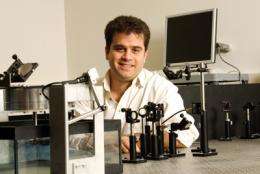Researchers investigate ultrasound use to treat cancer

(PhysOrg.com) -- It’s hard to imagine that cells and sound are related, but they are. According to one Ryerson University researcher, this relationship could mean big changes in cancer treatment, including more effective treatment monitoring, less invasive procedures and health care savings.
Dr. Michael Kolios, an Associate Professor in Ryerson’s Department of Physics and a Tier II Canada Research Chair in the Biomedical Applications of Ultrasound is examining how dying cancer cells scatter sound in ultrasound procedures.
“It’s like a rock falling into a pond,” explains Dr. Kolios. “Bigger rocks create bigger splashes and scatter ripples. In contrast, when cancer cells die and break into smaller pieces, that’s when their ‘splash’ scatters sound.” In particular, Dr. Kolios is analyzing the frequency emitted by cancer cells. The smaller the cells, the higher the frequency. Ultrasound operates in the same general way as radar - sounds waves are sent out and when they hit something, they bounce back. In this case, instead of detecting airplanes or ships, ultrasound is used to pinpoint and evaluate disease in the human body.
With the use of high-frequency ultrasound, doctors could determine a tumour’s response to therapy early on in treatment. As a result, better-informed decisions could be made as to whether to continue with the prescribed treatment plan or develop a different one. That’s the premise behind Dr. Kolios’ newest research endeavour. The project is part of Dr. Kolios’ larger research on ultrasound as a non-invasive way to investigate cell death, a collaboration with Gregory Czarnota, an Adjunct Physics Professor at Ryerson and a researcher at Sunnybrook Health Sciences Centre, and Assistant Ryerson Physics Professor Carl Kumaradas.
Dr. Kolios’ work could have significant impact on the way cancer treatments are monitored. Currently, patients must undergo a full course of radiation or chemotherapy before doctors assess whether or not the treatment has achieved its intended effect. Depending on the type of therapy, the cost of care can start at $60,000.
High-frequency ultrasound could also help patients improve their quality of life by avoiding the unpleasant side effects of traditional treatment, while potentially save the health-care system tens of thousands of dollars per treatment. That money, in turn, could be put toward the cost of another, more effective therapy.
Research on the use and outcomes of high-frequency ultrasound is timely. “As the population ages, more people are getting cancer,” says Dr. Kolios. In fact, according to the Canadian Cancer Society, approximately one in four Canadians will die of cancer, with the risk being slightly greater among men than women.
While Dr. Kolios is studying high-ultrasound frequencies (10 - 60 MHz), his research assistant Eric Strohm, a master’s student in Biomedical Physics is exploring ultra-high frequencies of more than 100 MHz. Frequencies in this range make up the field of acoustic microscopy and facilitate high-resolution viewing of single cells. Eric has co-authored two papers on acoustic microscopy with Dr. Kolios and will present the findings at a pair of international conferences this September.
Provided by Ryerson University














